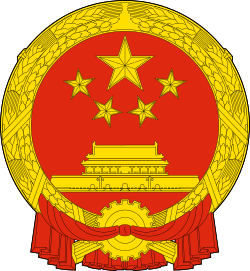China–Kiribati relations
 |
|
China |
Kiribati |
|---|---|
The Republic of Kiribati and the People's Republic of China (PRC) currently have no official diplomatic relations. The government of Kiribati recognises the Republic of China, and, in accordance with the "One China" policy, Beijing does not maintain formal relations with countries that recognise the ROC. However, the PRC and Kiribati maintained diplomatic relations in the past.
Context
- detailed article: Sino-Pacific relations
Oceania is, to the People's Republic of China and the Republic of China (Taiwan), a stage for continuous diplomatic competition. Eight states in Oceania recognise the PRC, and six recognise the ROC. These numbers fluctuate as Pacific Island nations re-evaluate their foreign policies, and occasionally shift diplomatic recognition between Beijing and Taipei. In keeping with the "One China" policy, it is not possible for any country to maintain official diplomatic relations with "both Chinas", and this "either/or" factor has resulted in the PRC and the ROC actively courting diplomatic favours from small Pacific nations.[1][2] In 2003, the People's Republic of China announced it intended to enhance its diplomatic ties with the Pacific Islands Forum, and increase the economic aid package it provided to that organisation. At the same time, PRC delegate Zhou Whenzhong added: "[T]he PIF should refrain from any exchanges of an official nature or dialogue partnership of any form with Taiwan".[3] In 2006, Chinese Premier Wen Jiabao announced that the PRC would increase its economic cooperation with Pacific Island States. The PRC would provide more economic aid, abolish tariffs for exports from the Pacific's least developed countries, annul the debt of those countries, distribute free anti-malaria medicines, and provide training for two thousand Pacific Islander government officials and technical staff.[4] Also in 2006, Wen became the first Chinese premier to visit the Pacific islands, which the Taipei Times described as "a longtime diplomatic battleground for China and Taiwan". Similarly, according to Ron Crocombe, Professor of Pacific Studies at the University of the South Pacific, "There have been more Pacific Islands minister visits to China than to any other country".[5]
History and current situation
Kiribati first established official diplomatic relations with the People's Republic of China in 1980, and maintained them for twenty-three years. In November 2003, Tarawa established diplomatic relations with Taipei, and Beijing severed its relations with the country. For the PRC, relations with Kiribati had been relatively important, since Beijing had a satellite-tracking station established there (since 1997). Therefore, for three weeks the PRC called upon I-Kiribati President Anote Tong to break off relations with Taiwan and re-affirm his support for the "One China" policy. Only after those three weeks did the PRC sever relations,[6] thereby losing the right to maintain its satellite-tracking base in Kiribati. The Republic of China began providing economic aid to Kiribati, while Kiribati began supporting Taiwan in the United Nations.
In 2004, President Tong said he believed the PRC was still trying to exert influence over his country.[7]
See also
References
- ↑ "The Pacific Proxy: China vs Taiwan", Graeme Dobell, ABC Radio Australia, February 7, 2007
- ↑ Young, Audrey (October 19, 2007). "Chequebooks brought out at Pacific forum". The New Zealand Herald. Retrieved November 2, 2011.
- ↑ "China announces initiatives to expand ties with PIF member countries", PRC embassy in Papua New Guinea, November 24, 2003
- ↑ "China offers aid package to Pacific Islands", China Daily, April 5, 2006
- ↑ "Chinese Premier Wen to visit the Pacific Islands", Taipei Times, April 3, 2006
- ↑ "China ceases diplomatic relations with Kiribati", PRC embassy in Estonia, November 29, 2003
- ↑ "Kiribati Plays The Game: Taiwan vs. China Battle Continues" Archived October 7, 2008, at the Wayback Machine., Mac William Bishop, Pacific Magazine, September 1, 2004
